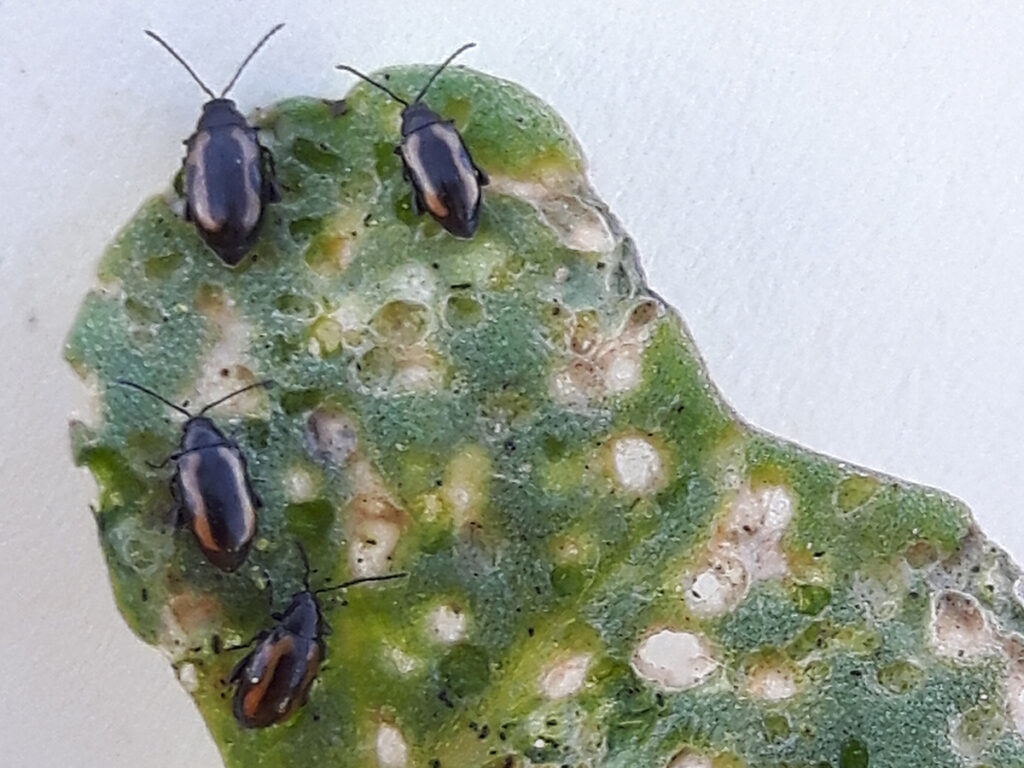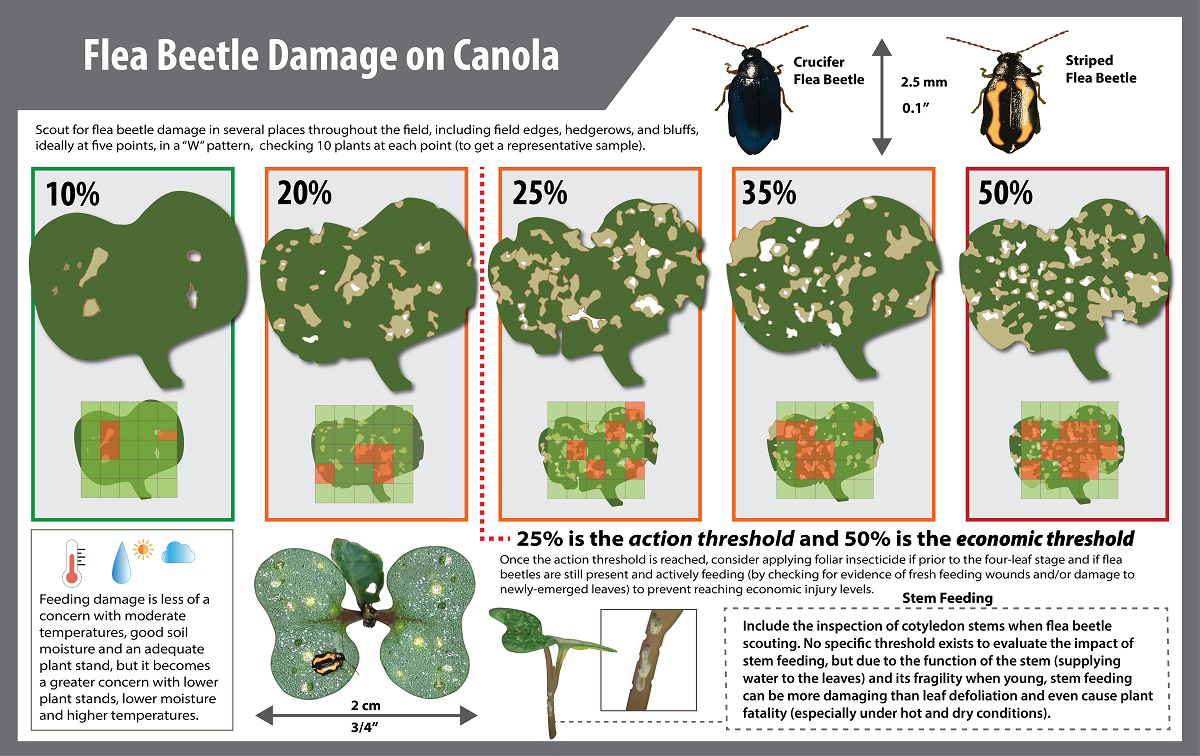Canola can be protected from flea beetle threat

Glacier FarmMedia – Jay Derkach may not get flea beetles on his farm every year, but when he does, it’s a mess. One year, they were so thick he had to use the windshield wipers on his tractor to scrape them off while seeding.
Conditions this spring are shaping up similarly to that infamous year, but the canola grower from Manitoba’s Parkland region isn’t seeing the same early pressure just yet.
“They’re not in the yard; they’re not on my windshield,” he said.
Read Also


Canola sector awaits Chinese anti-dumping investigation
The U.S. Department of Agriculture is forecasting robust Canadian canola exports in 2025-26 despite the potential loss of its top market.
“(We’ve had) moderate wind and a moderate winter. I thought it would have been the opposite.”
Derkach’s example highlights the unpredictability of the notorious canola pest.
Flea beetles wreak around $300 million in damages annually across the Prairies and were named the greatest economic risk to canola by last year’s Canola Council of Canada grower survey.
Keith Gabert, an agronomy specialist with the council, points to quick crop establishment for flea beetle control success.
“One of the challenges of flea beetles is they’re not consistent enough that a lot of growers get practice managing them,” he said.
“Nor would we wish that on anyone. But when flea beetles on yourparticular farm might only be a once-in-five-years issue or maybe longer, you sort of forget how much chewing they can do early in the season.”
First step: scout
Even with a seed treatment, and even if the producer can accept some marginal crop loss, flea beetle damage should always be scouted for during canola’s vulnerable seedling to early vegetative stages.
“Our message is simply to get out there and understand the risk and scout and make sure that you’re protecting that crop if you need to,” said Gabert.
The pests are versatile. They seem to crop up in both wet and dry years. Still, the expert noted, their behaviour has some common threads, such as a love for warmth.
“We see really active movement at and above about 15 C,” he said.
During a cool spring, beetles may still move in from the edges of the field, but “they don’t necessarily fly and move really aggressively if it’s cool.”
But cool conditions may also hurt the crop’s efforts to establish, and the seed treatment window might expire before plants can grow out of their vulnerable stage.
Know when to spray
A little flea beetle damage can become a big problem very quickly. High flea beetle numbers or a sudden jump in temperature — which spurs them to eat faster — can cause crops to disappear faster than they’re actually growing, said Gabert.
Derkach can attest to this: “You can go out there one day and two days later see 10 to 15 per cent more damage in any given day in the spring.”
The canola council has thresholds for economically signficant damage. If leaves are showing 25 per cent defoliation, it may be time for a foliar insecticide pass. However, leaf loss may be a call to spray earlier.
“My experience with growers has been that 10 and 15 per cent damage looks pretty ugly,” said Gabert.
“You don’t really like seeing that level of feeding on your canola, and the challenge is simply to get out there and look and be aware that it’s happening.”
Seed sensibly
Remember the rule about five to eight plants per sq. foot, the council also urges. Canola crops planted at that industry-recommended standard usually face minimal risk from flea beetles, assuming they establish quickly, said Gabert.
“More plants mean fewer beetles per plant — a situation more likely to keep leaf area loss below the threshold of 25 per cent (defoliation).”
Gabert referenced John Gavloski, an entomologist with Manitoba Agriculture, who says canola crops that reach the four-leaf stage within three to four weeks of seeding are less likely to need a foliar insecticide spray.
Reaching that stage in such a short timeframe can be a tall order, Gabert said, but added producers can hedge their bets with best practices and a little weather luck.
“It’s doing the best job of seeding you possibly can and ideally hoping for some rain a day or two after seeding … to settle the dust and make sure that the seed bed is moist and there’s no dry zones,” he said.
Producers may also thank themselves for stopping every once and a while to double check their air seeder calibration. Gabert advised checking seeding depth at numerous points along the width of the drill, particularly when changing fields or in shifting weather conditions.
The first day of seeding can set the pace for that season’s crop establishment.
“Slow down, seed shallow, make sure you’ve got enough seeds in the ground and hope that you’re not going to have any significant issues getting that crop established,” Gabert said.
Weather makes the difference
If you get a chance to seed your canola into warm, moist soil at a shallow depth, take it, said Gabert.
“Canola sown in warm, moist soil will emerge quickly and uniformly. Warm conditions without moisture will often favour flea beetles over the crop.”
Seeding later has emerged as one management strategy after repeated bad flea beetle years where cool temperatures stymied crop establishment. Canola hangs onto its yield potential better than some crops, and planting later into warmer soils can foster faster growth.
However, Gabert cautioned, that later crop may also end up flowering during hotter days when blossoms risk aborting or may not be ready to harvest until farmers are worried about frost.
Don’t chase moisture
Half an inch to an inch is the recommended seeding depth for canola. It’s not a recommendation that should be ignored to “chase” moisture lying further underground, warned Gabert.
“We almost never recommend chasing moisture with canola simply because that seed depth is a critical component of success.”


The recommendation has some wiggle room, but the canola expert urged caution.
“Some companies recommend an inch and a quarter, but to my mind, there’s really no difference between an inch or three-quarters of an inch or an inch and a quarter. The challenge is to not have it three inches down because the crop really struggles when you get much below that inch mark.”
Be safe with seed-placed fertilizer
Phosphorus is the only nutrient canola producers should be placing in the seed row, said Gabert. Even then, it should be no more than 20 pounds per acre of phosphate.
“Higher rates of seed-placed fertilizer add more stress, slow the pace of growth and reduce the stand,” he said.
Not all producers follow this advice, he added. The detriments of excess seed-placed fertilizer can go years without detection.
Gabert urges farmers who go heavier with the fertilizer to run test patches on places where they’ve shut down the flow of nutrients in two spots that can be seen from the road.
“If their crop looks better in those spots where they shut it off for the first three to five weeks, then they’re putting too much seed-placed fertilizer down,” he said.
Newer seed treatments
Today, even a basic seed treatment will likely contain three or four fungicides and an insecticide right out of the package.
However, there are new non-neonicotinoid “upgrades” that can be purchased to help tackle flea beetles in high-risk areas.
Lumiderm (active ingredient cyantraniliprole) is a Group 28 insecticide seed treatment, while Fortenza is another Group 28 treatment with the same active ingredient.
“These Group 28 products will provide cutworm control and a flea beetle control upgrade,” he said.
Then there’s Buteo Start, a Group 4D insecticide (flupyradifurone) treatment.
“It’s the newest of all of those,” said Gabert.
“The challenge for growers is to pick which one works, or you can, in some cases, get layered protection or multiple upgrades.”
Other field issues loom
Flea beetles are rarely the only problem in a field, said Gabert. There’s always something that may create or worsen the issue, be it poor establishment, soil crusting, seeding too deep or weather-related stress.
“For whatever reason, you end up with a few slow-growing plants and then you suddenly end up with beetles that want to eat whatever comes out of the ground and it’s a disaster.”
However, flea beetle challenges are never a “one strike, you’re out” event.
“If you happen to have large numbers and a poor-growing crop, then you need to scout aggressively and decide if you need to to put a foliar insecticide in addition to your seed treatment.”
Source: producer.com


